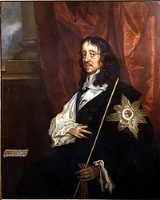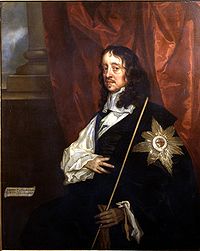
Thomas Wriothesley, 4th Earl of Southampton
Encyclopedia

Order of the Garter
The Most Noble Order of the Garter, founded in 1348, is the highest order of chivalry, or knighthood, existing in England. The order is dedicated to the image and arms of St...
(Wriothesley is pronounced "Risley"; 10 March 1607 – 16 May 1667), styled Lord Wriothesley before 1624, was a 17th century English
England
England is a country that is part of the United Kingdom. It shares land borders with Scotland to the north and Wales to the west; the Irish Sea is to the north west, the Celtic Sea to the south west, with the North Sea to the east and the English Channel to the south separating it from continental...
statesman, a staunch supporter of Charles II
Charles II of England
Charles II was monarch of the three kingdoms of England, Scotland, and Ireland.Charles II's father, King Charles I, was executed at Whitehall on 30 January 1649, at the climax of the English Civil War...
who would rise to the position of Lord High Treasurer
Lord High Treasurer
The post of Lord High Treasurer or Lord Treasurer was an English government position and has been a British government position since the Act of Union of 1707. A holder of the post would be the third highest ranked Great Officer of State, below the Lord High Chancellor and above the Lord President...
after the English Restoration
English Restoration
The Restoration of the English monarchy began in 1660 when the English, Scottish and Irish monarchies were all restored under Charles II after the Interregnum that followed the Wars of the Three Kingdoms...
. His term as treasurer began concurrently with the assumption of power by the Clarendon Ministry
Clarendon Ministry
The Clarendon Ministry was forged out of the royalist camp of Charles II, who was returned to the throne in 1660. Two years previously, Lord Hyde had been appointed Lord Chancellor, and in 1660, he was joined by several other powerful statesmen, including the heir presumptive of the English...
, but his death would precede Lord Clarendon's
Edward Hyde, 1st Earl of Clarendon
Edward Hyde, 1st Earl of Clarendon was an English historian and statesman, and grandfather of two English monarchs, Mary II and Queen Anne.-Early life:...
impeachment from the House of Commons
British House of Commons
The House of Commons is the lower house of the Parliament of the United Kingdom, which also comprises the Sovereign and the House of Lords . Both Commons and Lords meet in the Palace of Westminster. The Commons is a democratically elected body, consisting of 650 members , who are known as Members...
, after which the Cabal Ministry
Cabal Ministry
The Cabal Ministry refers to a group of high councillers of King Charles II of England, Scotland and Ireland from 1668 to circa 1674.The term "Cabal" has a double meaning in this context. It refers to the fact that, for perhaps the first time in English history, effective power in a royal council...
took over government.
Lord Southampton, having acceded to the earldom in 1624, attended St. John's College, Cambridge. At first, he sided with the Parliament
Long Parliament
The Long Parliament was made on 3 November 1640, following the Bishops' Wars. It received its name from the fact that through an Act of Parliament, it could only be dissolved with the agreement of the members, and those members did not agree to its dissolution until after the English Civil War and...
supporters upon the subjects leading to the English Civil War
English Civil War
The English Civil War was a series of armed conflicts and political machinations between Parliamentarians and Royalists...
, but upon his realisation of their leaders' violence, he became a loyal supporter of Charles I. While remaining very loyal to the deposed monarch, he still vied for peace, representing the king at several peace conferences (as Encyclopædia Britannica
Encyclopædia Britannica
The Encyclopædia Britannica , published by Encyclopædia Britannica, Inc., is a general knowledge English-language encyclopaedia that is available in print, as a DVD, and on the Internet. It is written and continuously updated by about 100 full-time editors and more than 4,000 expert...
notes, he attended at least two conferences: one in 1643, and one at Uxbridge in 1645). He was allowed to live within England
England
England is a country that is part of the United Kingdom. It shares land borders with Scotland to the north and Wales to the west; the Irish Sea is to the north west, the Celtic Sea to the south west, with the North Sea to the east and the English Channel to the south separating it from continental...
, having paid the Commonwealth over £6000.
Several months after the Restoration, Lord Southampton was appointed Lord High Treasurer (8 September 1660), a position in which he would serve until his death. As the Encyclopædia Britannica notes, Lord Southampton "was remarkable for his freedom from any taint of corruption and for his efforts in the interests of economy and financial order," a noble if not completely objective view of his work as the keeper of the nation's finances. Samuel Pepys
Samuel Pepys
Samuel Pepys FRS, MP, JP, was an English naval administrator and Member of Parliament who is now most famous for the diary he kept for a decade while still a relatively young man...
admired Southampton's integrity and the stoicism with which he endured his painful last illness, but clearly had doubts about his competence as Treasurer; in particular he graphically described the Council meeting in April 1665 where Southampton helplessly asked him where he was to find the funds requested.
Lord Southampton's name lives on in London
London
London is the capital city of :England and the :United Kingdom, the largest metropolitan area in the United Kingdom, and the largest urban zone in the European Union by most measures. Located on the River Thames, London has been a major settlement for two millennia, its history going back to its...
; both Southampton Row
Southampton Row
Southampton Row is major thoroughfare running northwest-southeast in Bloomsbury, Camden, central London, England. The road is designated as part of the A4200.- Location :To the north, Southampton Row adjoins the southeast corner of Russell Square...
and Southampton Street
Southampton Street
Southampton Street is a street in central London , England, running north from the Strand to Covent Garden Market.There are restaurants in the street such as Bistro 1and Wagamama. There are also shopssuch as The North Face outdoor clothing shop...
, Holborn
Holborn
Holborn is an area of Central London. Holborn is also the name of the area's principal east-west street, running as High Holborn from St Giles's High Street to Gray's Inn Road and then on to Holborn Viaduct...
are named after him.
Family
He was the only surviving son of Henry Wriothesley, 3rd Earl of SouthamptonHenry Wriothesley, 3rd Earl of Southampton
Henry Wriothesley , 3rd Earl of Southampton , was the second son of Henry Wriothesley, 2nd Earl of Southampton, and his wife Mary Browne, Countess of Southampton, daughter of the 1st Viscount Montagu...
and his wife Elizabeth Vernon.
He married three times and had three daughters. His first wife was French Huguenot
Huguenot
The Huguenots were members of the Protestant Reformed Church of France during the 16th and 17th centuries. Since the 17th century, people who formerly would have been called Huguenots have instead simply been called French Protestants, a title suggested by their German co-religionists, the...
Rachel de Massue (1603- 16 February 1640), the aunt of Henri de Massue, Marquis de Ruvigny, 1st Viscount Galway. Upon his death in 1667, his two daughters by Rachel, Elizabeth Wriothesley, Viscountess Campden, wife of Edward Noel, 1st Earl of Gainsborough
Edward Noel, 1st Earl of Gainsborough
Edward Noel, 1st Earl of Gainsborough was a British peer and member of the House of Lords, styled Hon. Edward Noel from 1660 to 1681....
and Rachel Wriothesley, the wife of William Russell, Lord Russell
William Russell, Lord Russell
William Russell, Lord Russell was an English politician. He was a leading member of the Country Party, forerunners of the Whigs, who opposed the succession of James II during the reign of Charles II, ultimately resulting in his execution for treason.-Early life and marriage:Russell was the third...
received all of their father's property. This property eventually passed to the Russell's only son, the 2nd Duke of Bedford
Wriothesley Russell, 2nd Duke of Bedford
Wriothesley Russell, 2nd Duke of Bedford KG was the son of William Russell, Lord Russell and his wife Lady Rachel Wriothesley...
.
His second marriage was to Lady Elizabeth Leigh, daughter of Francis Leigh, 1st Earl of Chichester
Francis Leigh, 1st Earl of Chichester
Francis Leigh, 1st Earl of Chichester was a Royalist politician and courtier around the period of the English Civil War....
from whom he inherited the title Earl of Chichester
Earl of Chichester
Earl of Chichester is a title that has been created three times in British history. It was created for the first time in the Peerage of England in 1644 when Francis Leigh, 1st Baron Dunsmore, was made Earl of Chichester, in the County of Sussex, with remainder to his son-in-law Thomas Wriothesley,...
on Leigh's death. Their only child, Lady Elizabeth Wriothesley
Elizabeth Percy, countess of Northumberland
Elizabeth Percy, Countess of Northumberland was a British courtier.She was one of the Windsor Beauties, painted by Sir Peter Lely.-Family:...
would, firstly, marry Joceline Percy, 11th Earl of Northumberland
Joceline Percy, 11th Earl of Northumberland
Josceline Percy, 11th Earl of Northumberland, 5th Baron Percy was an English peer.Percy was the eldest son of Algernon Percy, 10th Earl of Northumberland and his second wife, Elizabeth Howard, daughter of Theophilus Howard, 2nd Earl of Suffolk...
and upon his decease, she, secondly, married Ralph Montagu, 1st Duke of Montagu
Ralph Montagu, 1st Duke of Montagu
Ralph Montagu, 1st Duke of Montagu was an English courtier and diplomat.-Life:He was the second son of Edward Montagu, 2nd Baron Montagu of Boughton and Anne Winwood, daughter of the Secretary of State Ralph Winwood...
.

